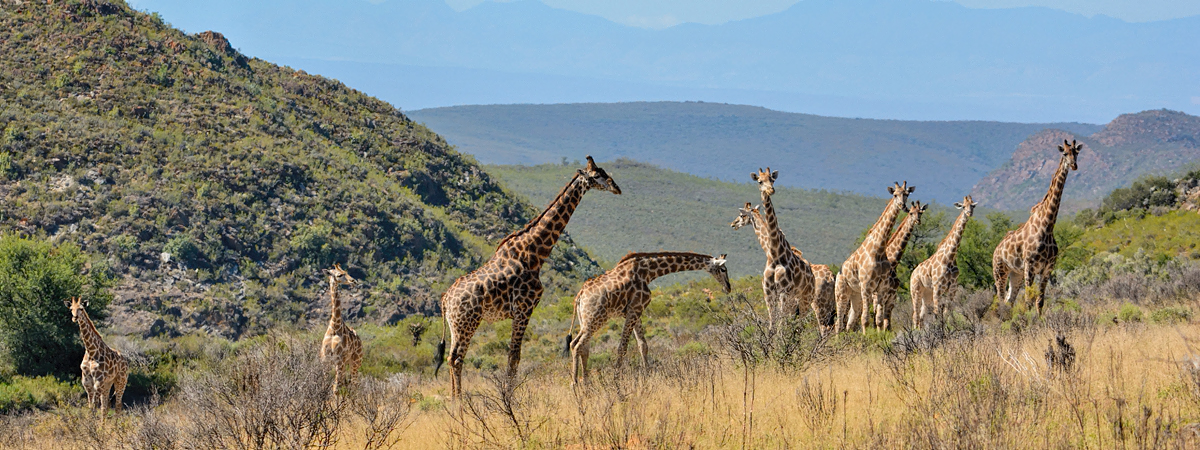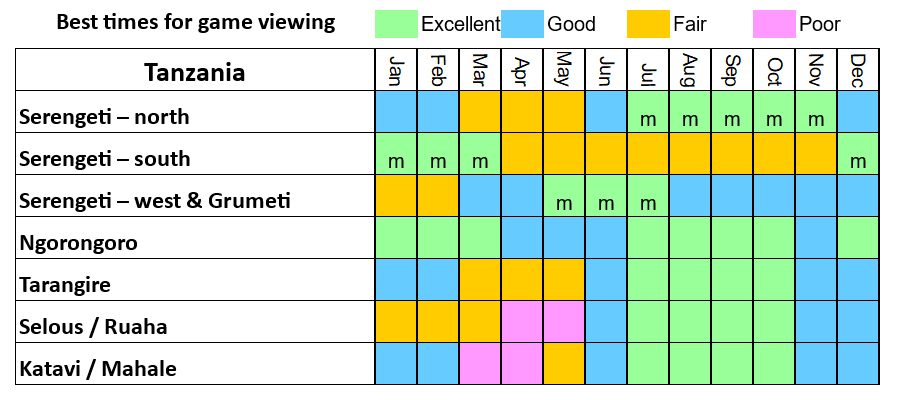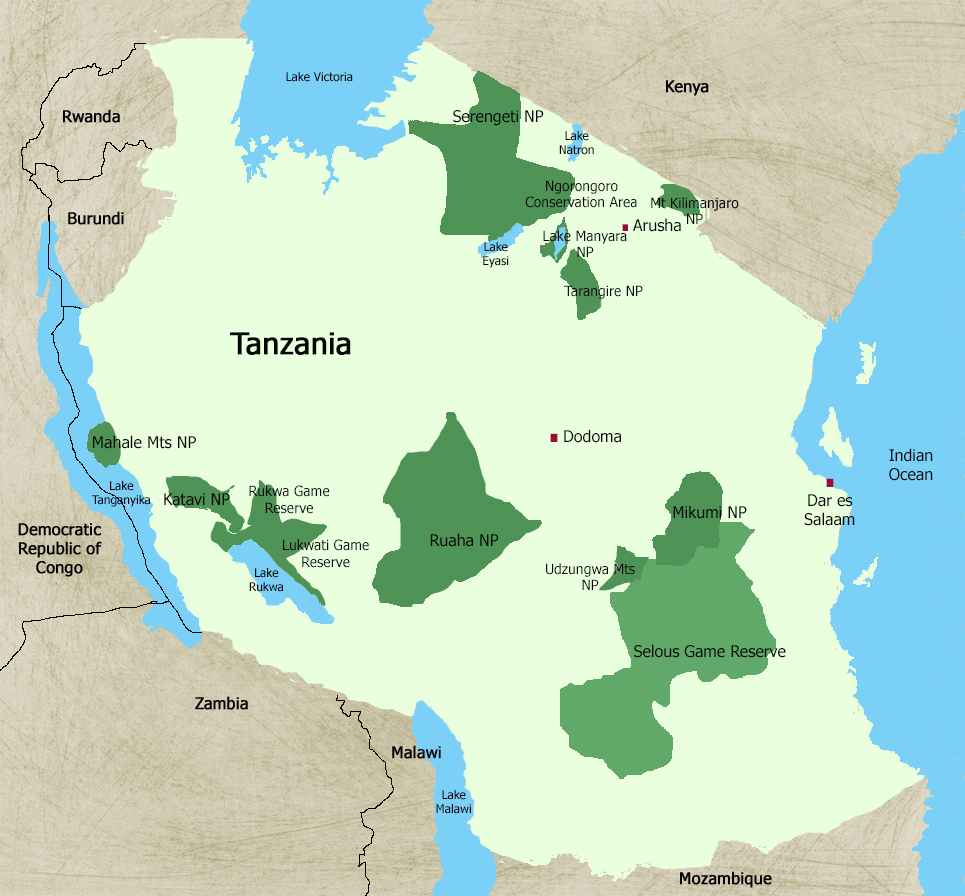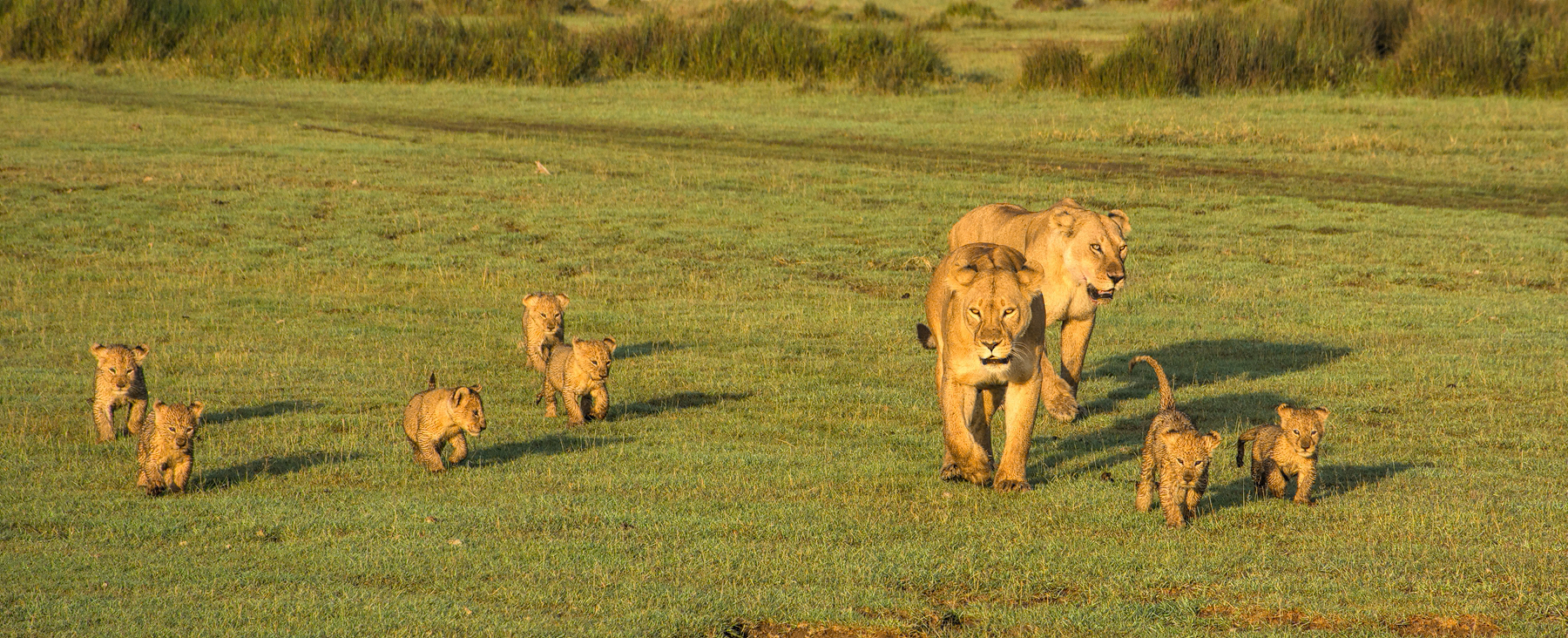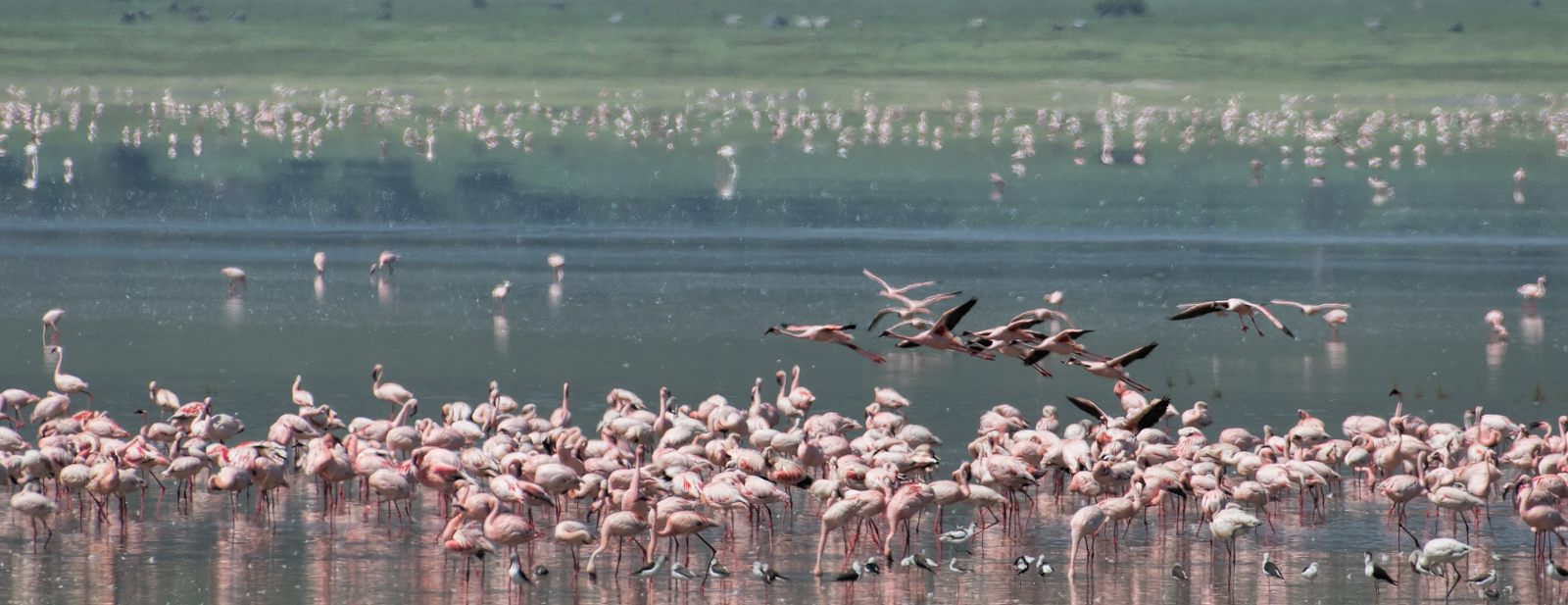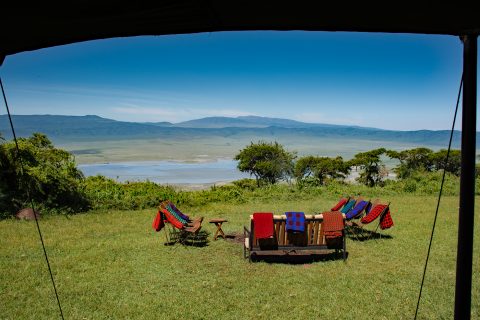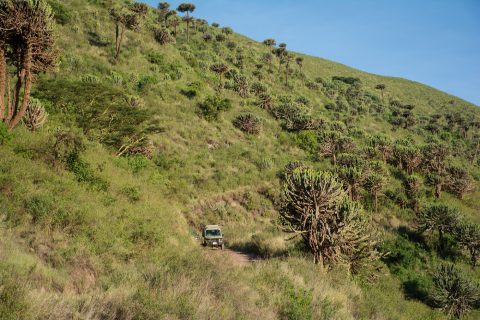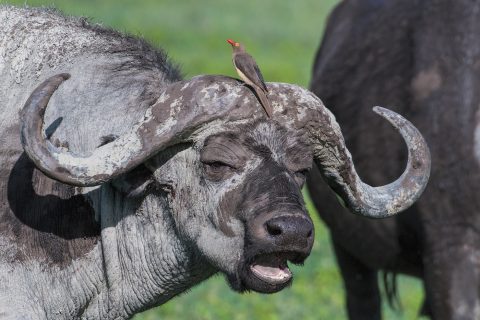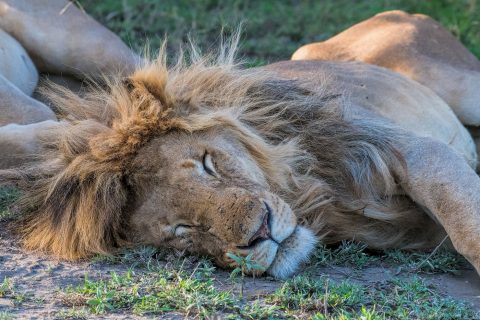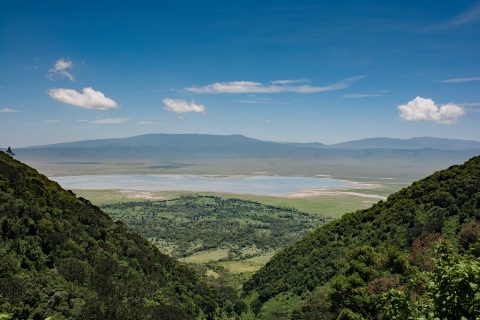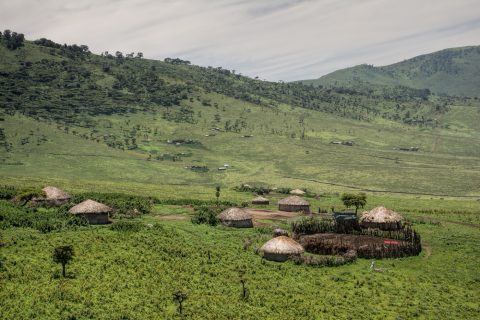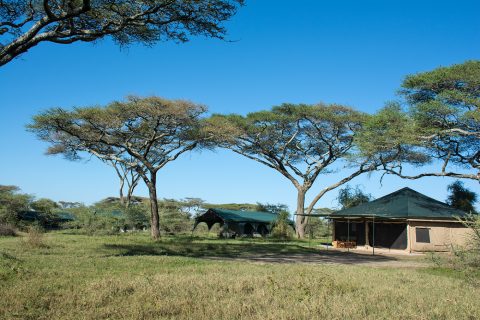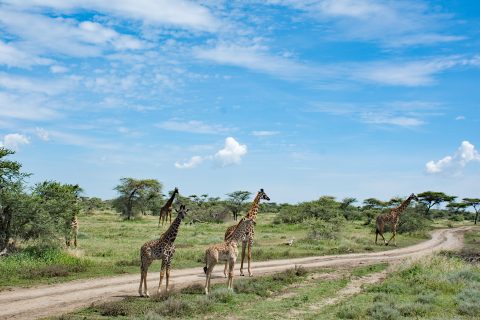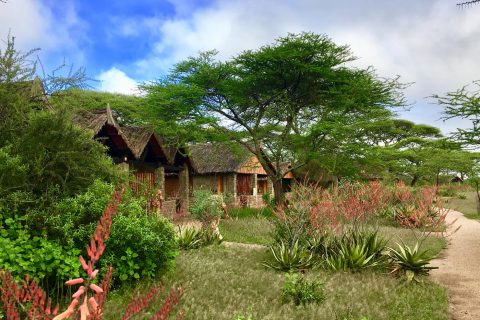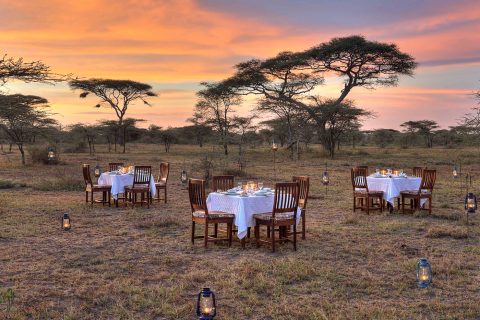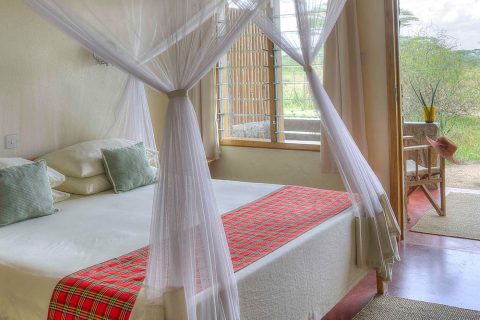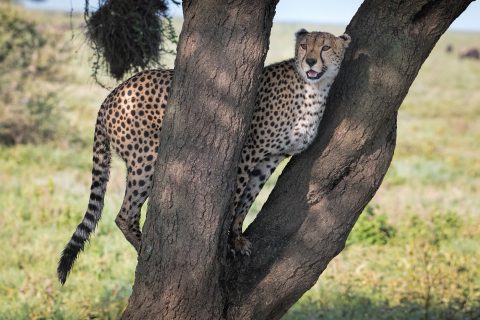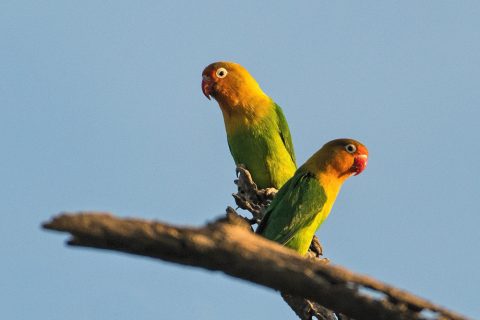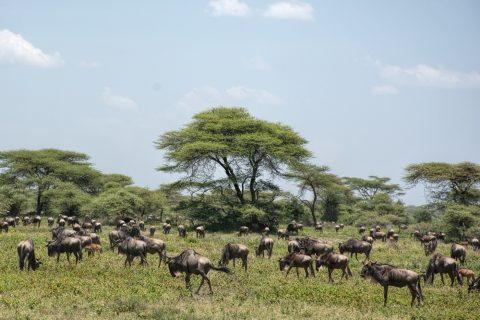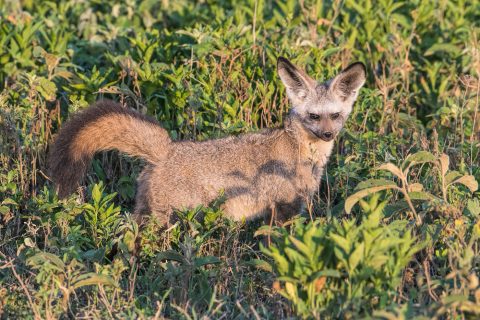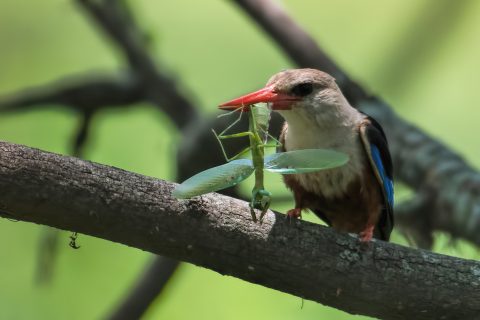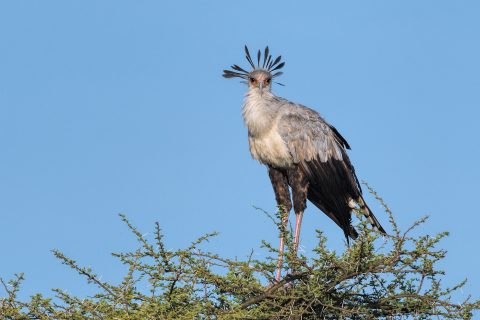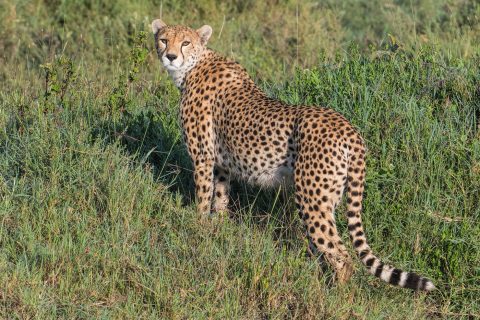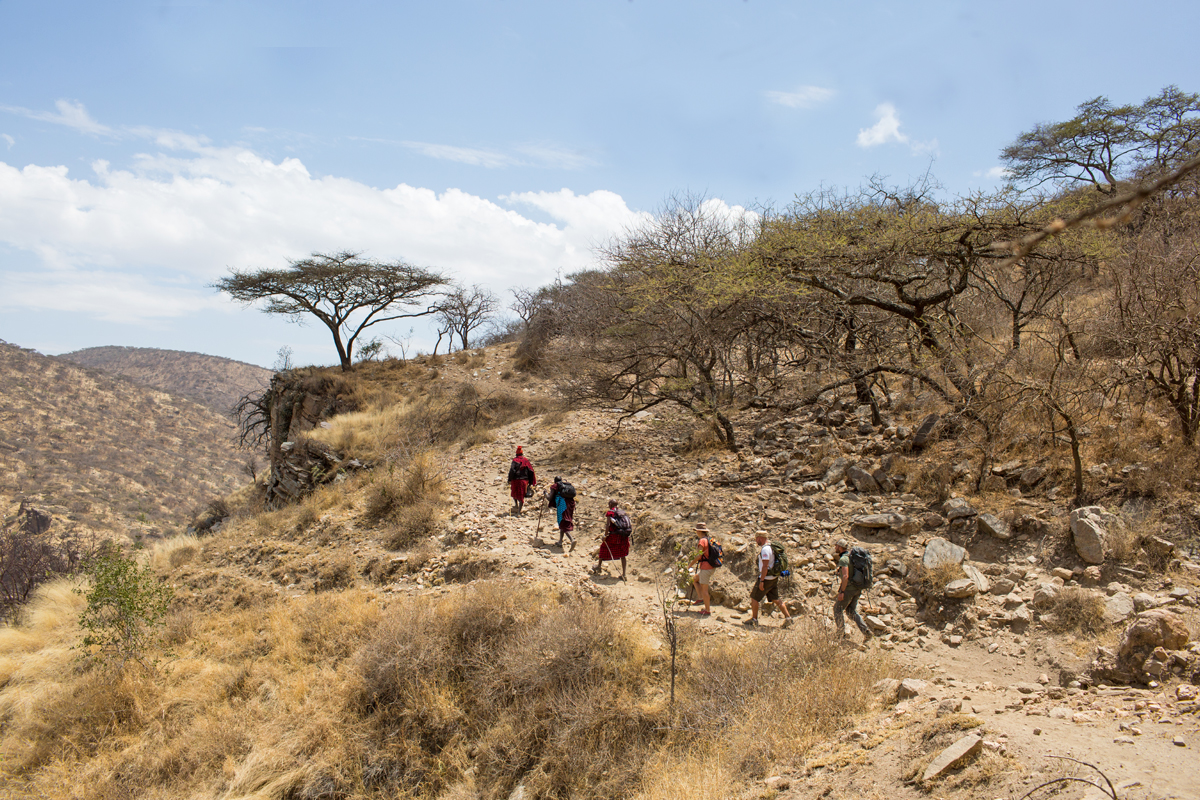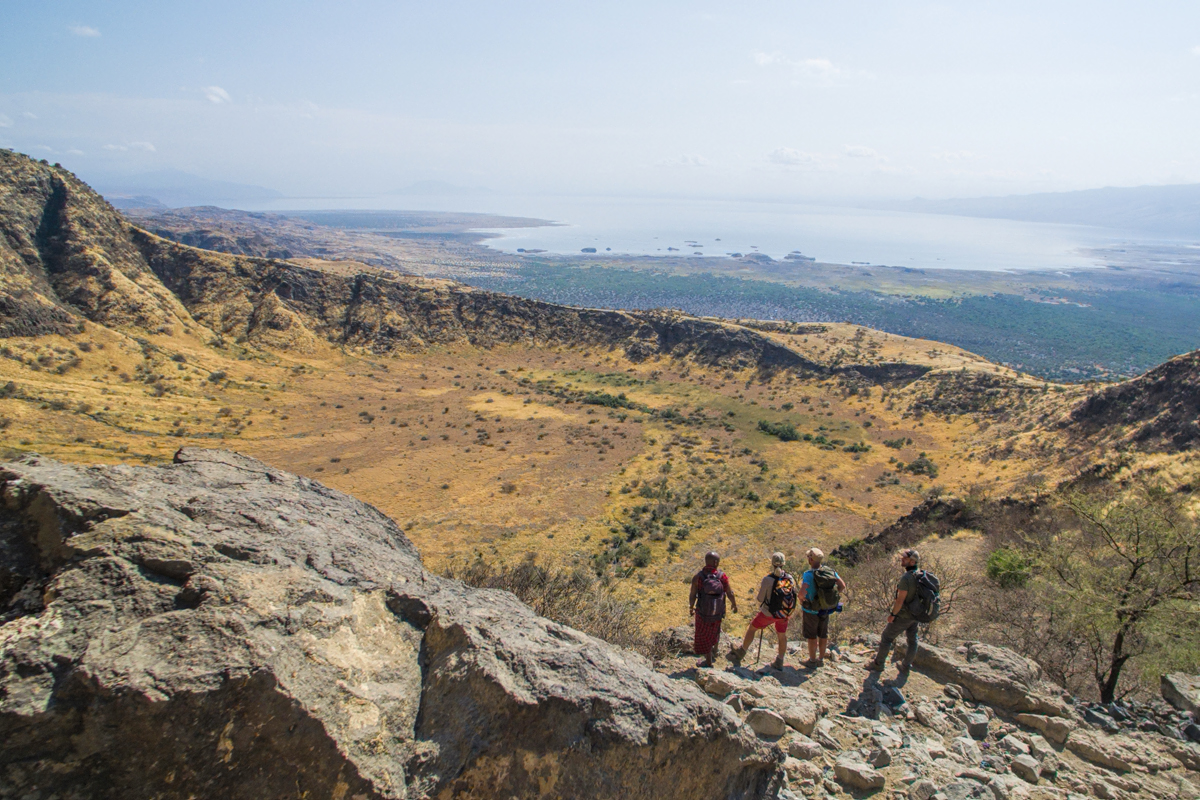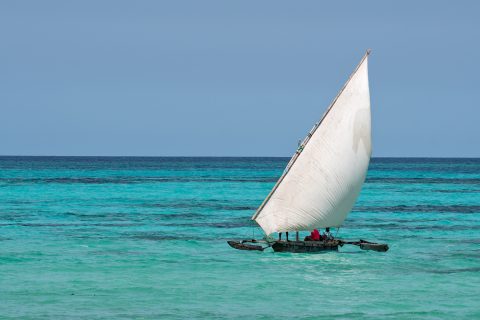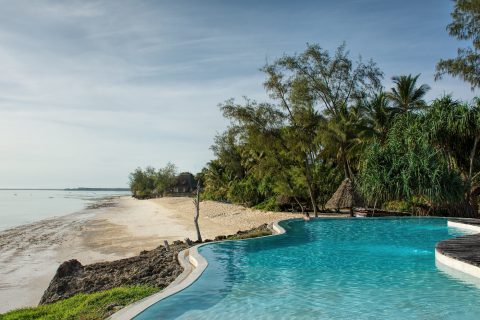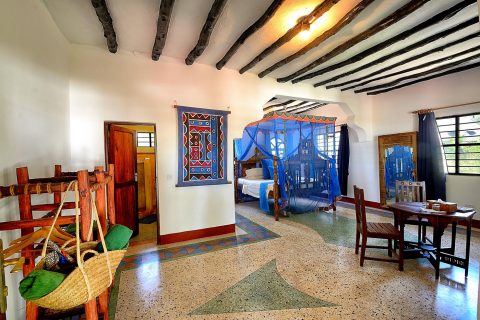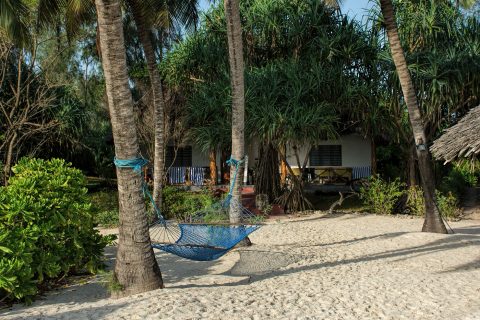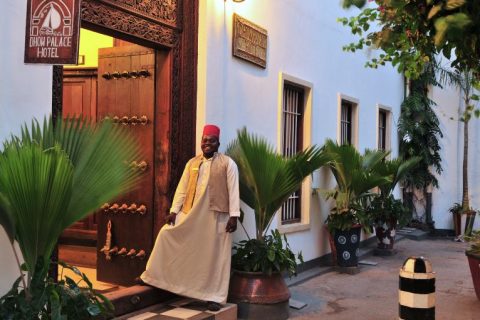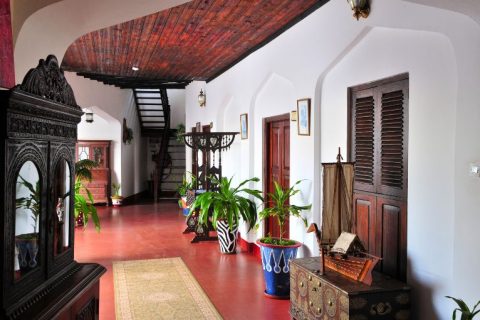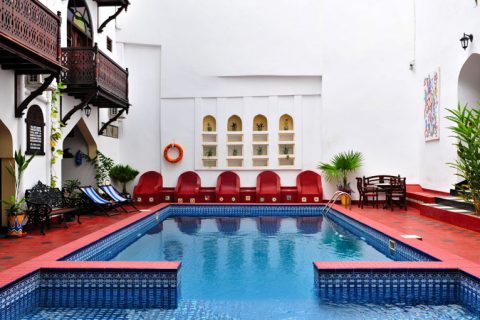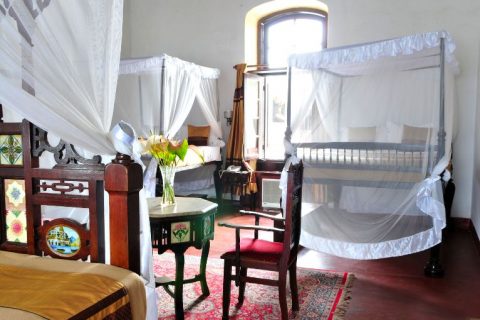Tanzania
One of the iconic safari destinations, Tanzania is home to some of Africa’s largest, and most famous, game reserves and offers wonderful safari experiences.
The Serengeti and Ngorongoro Crater will always deliver amazing game viewing, although at times they can feel a bit crowded. If you prefer a quieter safari experience then check out Selous and Ruaha National Parks; wildlife is still excellent but you’ll encounter few other vehicles.
Travel further west and you’ll encounter the massive gatherings of buffaloes and hippos that make Katavi NP so special and the chimpanzees of Mahale Mountains NP.
Africa’s highest mountain, Mt Kilimanjaro, is a magnet for those seeking to challenge themselves while the sandy beaches of Zanzibar offer a perfect escape for those who’d rather not.
Tanzania has international airports at Dar es Salaam, Arusha (Mt Kilimanjaro International) and on the island of Zanzibar.
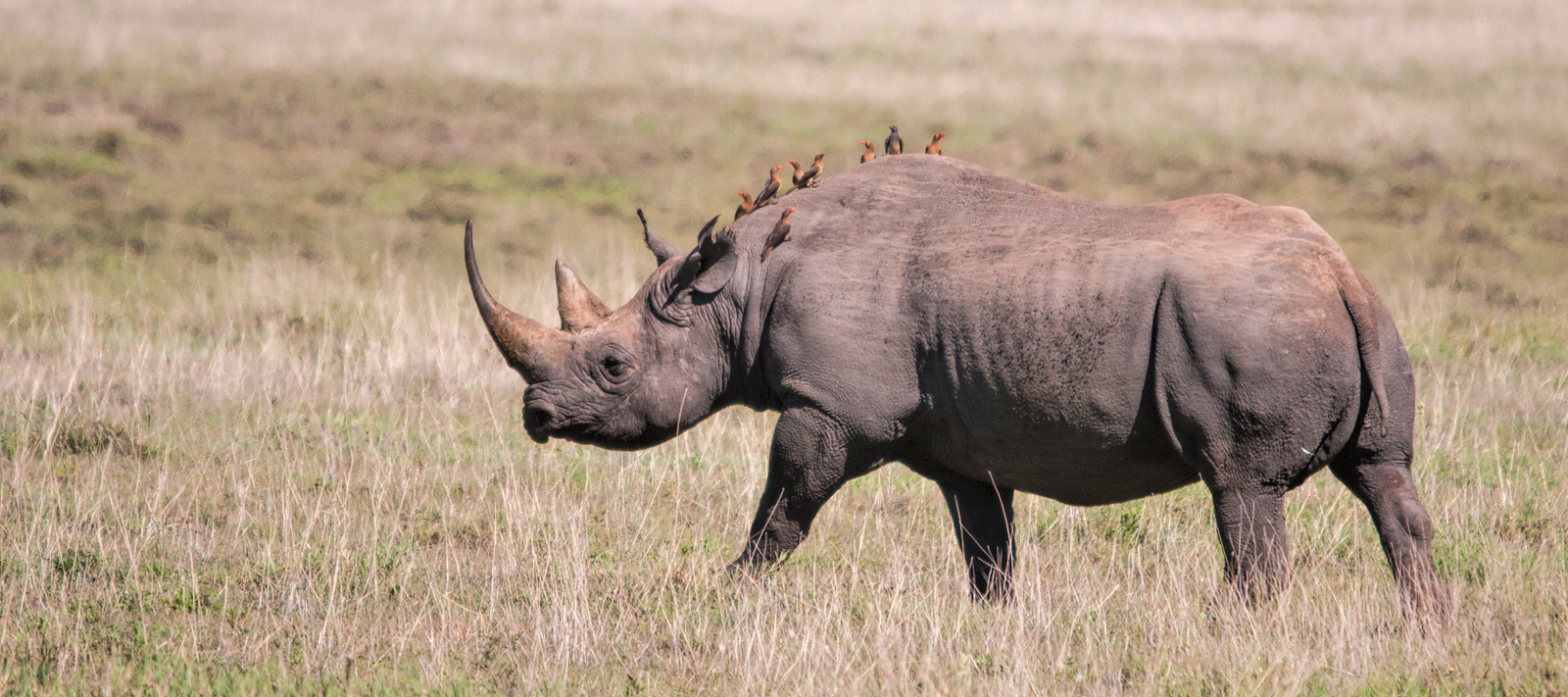

Note: Ngorongoro Conservation Area
Although our ‘Best places to see’ chart shows that there are no giraffes present, this refers to the Ngorongoro Crater itself; where there are no giraffes. However, within the greater Ngorongoro Conservation Area (NCA) there are giraffes in abundance.
If you are visiting Ndutu ( an area of the NCA) to witness the annual wildebeest migration you will almost certainly see plenty of giraffes.
Tanzania National Parks
Size: 330 sq km (127 sq miles), of which up to 200 sq km (77 sq miles) is lake when water levels are high.
Location: In northern Tanzania approximately 1.5 hours (126km/80 miles) west of Arusha along a newly surfaced road, close to the ethnically diverse market town of Mto wa Mbu.
Because Lake Manyara is on the way from Arusha to Ngorongoro and Serengeti it tends to get a lot of traffic, with many safari companies using it as a filler.
In terms of animal viewing Lake Manyara is mediocre. It used to be renowned for tree climbing lions but in the absence of such a sighting the remaining game does not often excite. However, where Lake Manyara excels is in its bird life. The lake itself attracts a wide variety of water birds and the surrounding forests are teeming with an amazing number of species. Our preference is to include Lake Manyara for clients and groups that are keen on bird life but to omit from other itineraries.
The Ngorongoro Conservation Area (NCA) is not a National Park, it is a conservationa area and a UNESCO World heritage Site located 180 km (110 mi) west of Arusha.
Ngorongoro Crater, inside the NCA, is recognized as one of the Seven Natural Wonders of Africa.
For such a compact area the Ngorongoro Crater has incredibly prolific wildlife including the Big Five.
Because it is such a small area and such an icon of Tanzania’s northern circuit it does get horribly crowded with Land Cruisers almost bumper to bumper in some places and stacked 3 deep whenever there is a significant sighting. Despite this it is a unique wildlife habitat and, with a bit pf planning, can still be a very rewarding experience. It should definitely be included in a first time visitor’s itinerary.
Size: 14,763 sq km (5,700 sq miles).
Location: 335km (208 miles) from Arusha, stretching north to Kenya and bordering Lake Victoria to the west.
The name “Serengeti” is an approximation of the Maasai word siringet, which means “the place where the land runs on forever.”
Serengeti is Tanzania’s oldest National Park, the flagship of the country’s safari industry and a must for any first time visitor to Tanzania. As such it attracts huge numbers of visitors but the park’s sheer size means that there is plenty of space for everyone and although key sightings do draw a lot of vehicles it is not difficult to get away from the crowds.
The majority of visitors to the Serengeti tend to stay in the central area, where most of the lodges and camps are.
At almost any time of year the Serengeti offers visitors a magnificent game viewing experience, except for the rainy months (Mar/Apr/May). For those wishing to witness the annual wildebeest migration as it travels northwards there excellent camps in all key locations from Ndutu in the southwest, through Grumeti in the Central Serengeti to Serengeti Mara and the Mara River in the north.
Accommodation is not as prolific as in Masai Mara so it makes sense to book as far in advance as you are able to make sure you secure the camp you want on the dates you want.
Location: 118 km (75 miles) southwest of Arusha.
Tarangire’s landscapes are notable for the abundance of Baobab trees that seem to be everywhere.
One of the main features of the park is the seasonal Tarangire River, which draws animals from nearby Lake Manyara in the dry season. Tarangire has excellent birdlife a huge numbers of elephants and a good variety of cats.
Few visitors spend any length of time in Tarangire and most do not get very far from the main gate which is a shame because it is a beautiful park and, with its proximity to Arusha, makes a nice gentle introduction to a Tanzanian safari.
There are some lovely camps beside the Tarangire River, both inside and just outside the park.
These two parks are in Southern Tanzania to the west of Morogoro; accessible via a pretty good road from Dar Es Salaam.
There are so many better parks than Mikumi in Tanzania that it is not really worth a visit unless you are driving to Selous and want to break your journey. Even then this would depend on the road between Mikumi and Selous being open.
If you are amongst the few that drive to Ruaha, then you will pass the Udzungwa Mountains NP.
Rising to altitudes of 2500m it offers a very different experience to a lowland park and is worth a visit if you have an interest in monkeys.
The Sanje Crested Mangebey and the Hehe red Colobus are endemic to the area and you also encounter black and white colobus, Blue Sykes Monkeys and vervet monkeys as well as abundant birdlife.
Ruaha National Park is the largest national park in Tanzania. It covers an area of about 22,000 km². It is located in the middle of Tanzania about 130 km from the town of Iringa.
Ruaha is famous for its large population of elephants, of which around 10.000 are currnently roaming the park. Other notable mammals include African Wild Dog and Sable Antelope. Ruaha is also a birdwatcher’s paradise where 436 species have been identified from an estimated total of 475.
The best times to visit for predators and large mammals is the dry season (May–December) and for birds and flowers, the wet season (January–April).
The landscapes of Ruaha are spectacular and provide a terrific backdrop for your game drives and photographs. The park’s remoteness from Dar es Salaam means that almost all visitors arrive by light aircraft and its size means that you are not likely to encounter too many other vehicles when you are on game drives. It is one of those parks where game drives are an absolute pleasure.
We have found that it is hard to do Ruaha justice in just one or two days and that to get the best from your visit it is worth staying 4-5 days and splitting your stay between two camps in different regions of the park.
The Selous Game Reserve is one of the largest faunal reserves of the world, located in the south of Tanzania. It was named after Englishman Sir Frederick Selous, a famous big game hunter and early conservationist, who died at Beho Beho in this territory in 1917 while fighting against the Germans during WW1. The Selous was designated a UNESCO World heritage Site in 1982 due to the diversity of its wildlife and undisturbed nature.
The whole Selous reserve is massive and covers a total area of 54,600 km2 (21,100 sq mi). However, on the small portion of the park which lies on the north east side of the Rufiji River is open to photographic tourism. The vast majority of the park, to the south west of the Rufiji is split between designated hunting concessions.
Some of the typical animals of the savannah Elephant, Buffalo, African Wild Dog can be found in this park in larger numbers than in any other African game reserve or national park.
Game drives in the Selous can be exceptional but when the bush is green following rainfall the animals are spread far and wide and often hard to track down.
What the Selous does have though is the Rufiji River and an afternoon boat trip on the river is one of the highlights of any visit. From the boat you will see elephants and other mammals coming to the river to drink and bathe and a delightful variety of birdlife, including a heronry and a colony of White Fronted Bee Eaters.
Due to its location visitors usually arrive in the Selous by light aircraft. For such a large park there are relatively few camps and so vehicle traffic is very light, making game drives a joy.
Size: 4,471 sq km (1,727 sq miles).
Location; Southwest Tanzania, east of Lake Tanganyika.
Katavi National Park was created in 1974. Though it is the third largest park in Tanzania, its remoteness means that it gets few visitors; just a few hundred each year.
The park encompasses the Katuma River and the seasonal floodplains of Lake Katavi and Lake Chada.
Katavi is renowned for its massive herds (1,000 plus animals) of buffalo and elephant as well as for vast numbers of hippo and crocodile; but the real joy of Katavi is that due to low visitor numbers you’ll be able to enjoy your safari almost totally undisturbed.
Access to Katavi is almost exclusively by light aircraft and the few lodges/camps that exist are on the pricey side.
Size: 1,613 sq km (623 sq miles).
Location: Western Tanzania, bordering Lake Tanganyika.
Mahale Mountains National Park lies on the eastern shore of Lake Tanganyika.
Named after the Mahale Mountain range that lies within its borders, the park has several unusual characteristics.
First, it is one of only two protected areas for chimpanzees in the country. Thanks to its remoteness, the chimpanzee population in Mahale Mountains National Park is large and flourishing. It also the only place where chimpanzees and lions co-exist.
Another unusual feature of the park is that it is one of the very few in Africa that must be experienced by foot. There are no roads or other infrastructure within the park boundaries, and the only way in and out of the park is via boat on the lake.
Mahale Mountains adds a wonderful contrast to safaris in other parks. It is not just the wildlife that is different but the whole experience.
Access to Mahale Mountains NP is by light aircraft and accommodation is not cheap but the experience will be long remembered.
Safari Ideas
Here are just a few suggestions, based on safaris that have worked well for past clients. They are not set in stone and can be easily amended to suit your requirements; changing lodges or duration. Or we can just start with a clean sheet pf paper.
Why not get in touch to discuss your ideas with us, there’s nothing we enjoy more than talking about Africa.
Then we can get to work on designing a very special safari just for you.
Private Safaris in Northern Tanzania
Our suggested itineraries in northern Tanzania are season dependent, so the places we recommend are determined by the time of year you are planning to travel. Conversely, if you want to visit a particular park, it is important to pick the right time of year to see it at its magnificent best.
In the early part of the year the main focus is the Ndutu area of southern Serengeti where hundreds of thousands of wildebeest gather before beginning their migration north to Kenya’s Masai Mara.
Later in the year, our time in Serengeti is spent further north, as the herds cross back and forth over the Mara river, braving crocodile infested waters. At this time we also recommend spending time in Tarangire National Park, renowned for one of the densest concentrations of wildlife outside the Ngorongoro Crater and also for an amazing variety of bird species.
Whichever season you choose for your visit to Tanzania, you’re assured of a safari to remember.
These suggested itineraries are priced on the basis of 2 people travelling together with a private vehicle and guide.
January, February, March
The beginning of the year, just before the rainy season gets under way, is the time when huge numbers of wildebeest gather on the plains of southern Serengeti and Ndutu in preparation for their migration north to Kenya’s Masai Mara.
Here you will find yourself surrounded by wildlife; with thousands – hundreds of thousands actually – of wildebeest and zebra milling around.
For wildebeest, zebra as well as gazelles and other animals it is the time when they give birth, so it is a wonderful time to see young and new born animals.
With so many animals congregated here it is hardly surprising that this is also a prime time for sighting predators as they follow the herds in search of an easy meal and the nights are filled with the roar of lions.
Our suggested itinerary for this time of year will put you right in the thick of the action, visiting Lake Manyara, Ngorongoro Crater and the Ndutu plains.
You can choose whether to stay in tented camps throughout or swap our camp in Ndutu for a few nights in the stone cottages at Ndutu Safari Lodge.
Arusha NP - Lake Manyara NP - Ngorongoro Crater - Serengeti
Suggested Itinerary
8 nights / 9 days
Day 1 – Upon arrival at Kilimanjaro International airport (JRO) you will be met and transferred the short distance to Mt Meru Game Lodge, where you can relax and recover from your long flight.
Day 2 – After breakfast visit Arusha NP, then transfer to Lake Manyara.
Day 3 – Visit Lake Manyara NP, famous for its abundant bird life and tree climbing lions. After picnic lunch transfer to our camp, right on the rim of the Ngorongoro Crater.
Day 4 – An early breakfast before descending into the Ngorongoro Crater. After a picnic lunch, drive to Ndutu.
Days 5 & 6 – 2 full days to immerse your self in the vast herds of wildebeest gathering here. With so many animals giving birth the area is a magnet for predators and you can expect to see lions and cheetahs; often with young of their own.
Day 7 – After breakfast leave Ndutu to explore the spectacular Gol Kopjies, before ending the day at our camp in Serengeti.
Day 8 – Game drives in central Serengeti.
Day 9 – After breakfast in camp, transfer to the to airstrip for flight a to Arusha
Price includes:
- All accommodation and meals
- Private vehicle and guide
- AMREF flying doctors insurance
- All current government Taxes relevant to the itinerary All entry fees for national parks, conservation fees, reserve fees relevant to this itinerary
- Flight from Serengeti to Arusha on Day 9
- Specially adapted 4×4 game drive vehicle with window seats for all passengers, reference books (flora / fauna / avifauna)
- Bottled water in vehicle during game drives
Accommodation:
1 night – Mt Meru Game Lodge
1 night – Kirurumu Tented Lodge, Lake Manyara
1 night – Pakulala Tented Camp, Ngorongoro Crater
3 nights Ndutu – either Kirurumu Ndutu Tented Lodge or Ndutu Safari Lodge
2 nights Kirurumu Tented Lodge, Central Serengeti
July, August, September, October, November
At this time of year Tarangire NP is one of the prime game viewing areas in the country; with herds of elephants roaming the landscape amid towering Baobab trees. The density of game here is second only to the Ngorongoro Crater and the bird life is spectacular.
From Tarangire we move north to Lake Manyara and then the unique wildlife habitat that is the Ngorongoro Crater, before entering the Serengeti where the rains have finished and the wildebeest herds have migrated north to the banks of the Mara river.
Here they can be seen braving crocodile infested waters as they cross the river, often multiple times, in search of the best grazing.
Arusha NP - Tarangire NP - Lake Manyara NP - Ngorongoro Crater - Serengeti
Suggested Itinerary
10 nights / 11 days
Day 1 – Upon arrival at Kilimanjaro International airport (JRO) you will be met and transferred the short distance to Mt Meru Game Lodge, where you can relax and recover from your long flight.
Day 2 – After a morning visit to Arusha NP, transfer to Tarangire NP.
Days 3 & 4 – 2 days to discover for yourself what makes Tarangire so special. Abundant Baobab trees create a wonderful landscape and the plentiful wildlife includes large herds of elephants.
Day 5 – A final morning game drive before departing for Lake Manyara.
Day 6 – A morning safari in Lake Manyara NP then depart for the Ngorongoro Conservation Area. Tonight’s accommodation is in a tented camp right on the rim of the Ngorongoro Crater, with spectacular views over the plains below.
Day 7 – After breakfast descend into the Ngorongoro Crater, home to Africa’s densest concentration of wildlife. Take a picnic lunch before driving to Serengeti NP.
Day 8 – A full day game drive to the imposing Gol Kopjies.
Day 9 – Make your way through the park to the northern section of Serengeti where wildebeest herds should be massing around the Mara river.
Day 10 – Game drives in Serengeti north.
Day 11 – After breakfast transfer to the airstrip for a flight back to Arusha
Price includes:
- All accommodation and meals
- Private vehicle and guide
- AMREF flying doctors insurance
- All current government Taxes relevant to the itinerary All entry fees for national parks, conservation fees, reserve fees relevant to this itinerary
- Flight from Serengeti to Arusha on Day 11
- Specially adapted 4×4 game drive vehicle with window seats for all passengers, reference books (flora / fauna / avifauna)
- Bottled water in vehicle during game drives
Accommodation:
1 night – Mt Meru Game Lodge
1 night – Kirurumu Tented Lodge, Lake Manyara
1 night – Pakulala Tented Camp, Ngorongoro Crater
3 nights Ndutu – either Kirurumu Ndutu Tented Lodge or Ndutu Safari Lodge
2 nights Kirurumu Tented Lodge, Central Serengeti
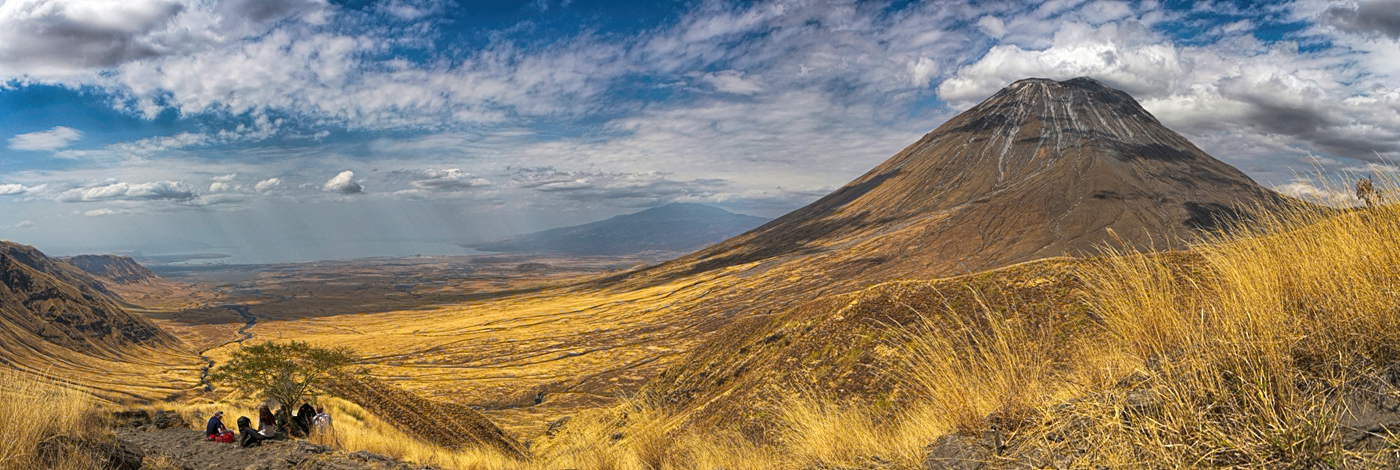
Empakai to Lake Natron Trek
5 nights / 6 days
starts and ends in Arusha
Why not extend your safari in Tanzania with a trek beyond the main tourist areas.
Setting out from the rim of the Ngorongoro Crater you’ll trek to Empakai Crater in the Ngorongoro highlands. You then trek down the rift valley with stunning views throughout then transfer to Lake Natron Camp (Ngare Sero) and use this as a base for activities such as seeing the flamingoes on Lake Natron, visiting the hominid footprints, delving deep into the Ngare Sero gorge or even just relaxing in camp and enjoying the natural plunge pools.
1 night – Ngorongoro Sopa Lodge
1 night – Empakai Private Campsite
1 night – Lerai Camp
2 nights – Lake Natron Camp
Zanzibar
Extend your stay with a few days on the Indian Ocean island of Zanzibar for the ultimate Bush & Beach combination.
Whether you choose to stay by one of the island’s stunning beaches or place yourself in the heart of old Stone Town, Zanzibar has plenty to offer.
Pongwe Beach Hotel
Pongwe Beach Hotel is situated on a picture perfect beach with white powdery sands, turquoise waters and shady palm trees – the perfect holiday destination!
Renowned as one of the most laid back hotels on the island, Pongwe Beach has a wonderfully stress free ambiance in a stunning location.
The restaurant offers a variety of meals with fresh seafood and fish available daily; while still being small enough to cater for all dietary requirements. Our bar stocks local and imported drinks as well as making daily fresh juices and cocktails.
Stone Town is 1 hour away by taxi.
Dhow Palace Hotel – Stone Town
The Dhow Palace serves as a meeting point for people and cultures from all over the world amidst a decor and artefacts from a time gone by.
Dhow Palace was originally the home of a rich merchant, Sheikh bin Mujbia. Bin Mujbia and his descendants kept the building for more than three centuries before it was sold. In 1993 it was transformed from a family mansion to this elegant hotel, with a new wing being added in 2005.
The Dhow Palace has been described by some as a living museum dedicated to furniture, art and oriental ornaments which have found their way to the shores of Zanzibar over the past centuries.

